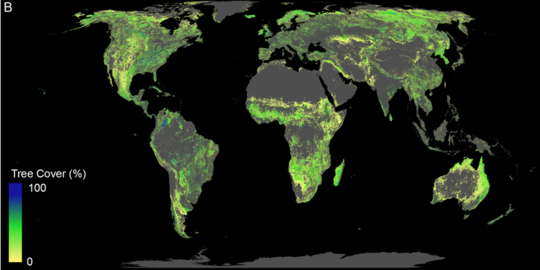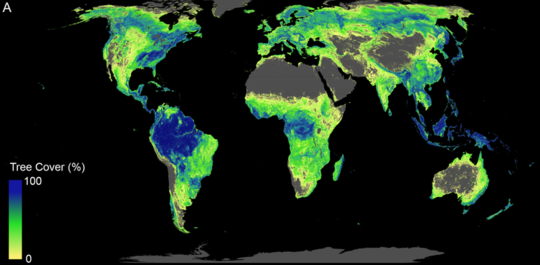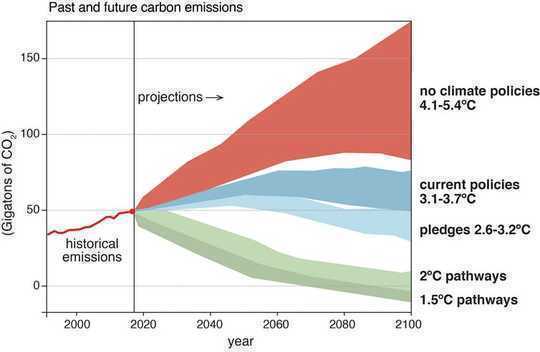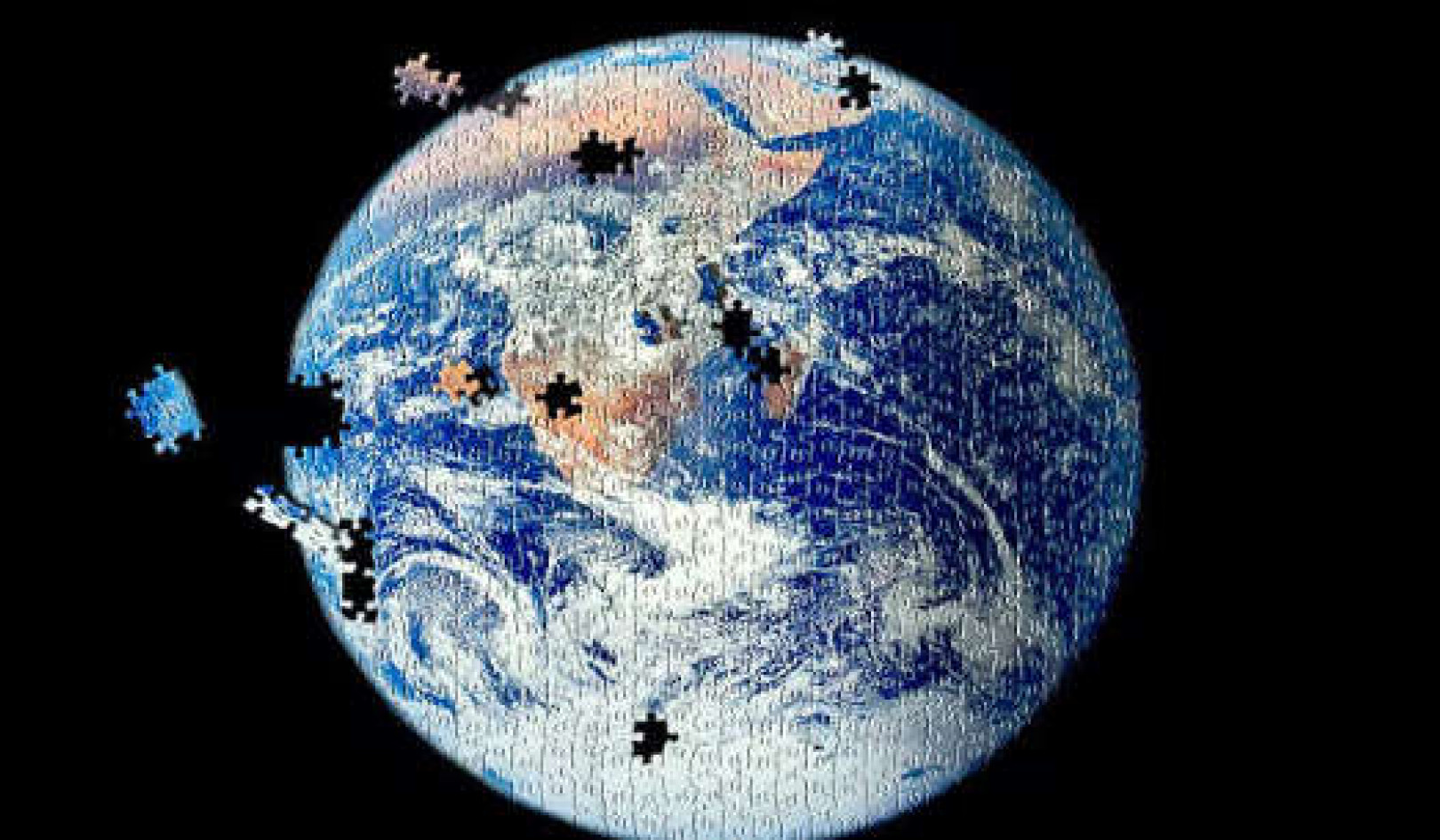Restoring the world’s forests on an unprecedented scale is “the best climate change solution available”, according to a new study. The researchers claim that covering 900m hectares of land – roughly the size of the continental US – with trees could store up to 205 billion tonnes of carbon, about two thirds of the carbon that humans have already put into the atmosphere.
While the best solution to climate change remains leaving fossil fuels in the ground, we will still need to suck carbon dioxide (CO?) out of the atmosphere this century if we are to keep global warming below 1.5?C. So the idea of reforesting much of the world isn’t as far-fetched as it sounds.
Since the dawn of agriculture, humans have cut down three trillion trees – about half the trees on Earth. Already 43 countries have pledged to restore 292m hectares of degraded land to forest worldwide. That’s an area ten times the size of the UK. But what the new study advocates is reforesting something like ten times that amount.
 Trees absorb CO? from the air and store the carbon as bark and other tissue. Mark Maslin, Author provided
Trees absorb CO? from the air and store the carbon as bark and other tissue. Mark Maslin, Author provided
Rewilding habitats and reforesting may be easier in the future as the world is already becoming a wilder place in many areas. This may seem a strange prediction, given that the global population will grow from 7.7 billion to 10 billion by 2050, but by then nearly 70% of us will live in cities and have abandoned rural areas, making them ripe for restoration. In Europe already, 2.2m hectares of forest regrew per year between 2000-2015, and forest cover in Spain has increased from 8% of the country’s territory in 1900 to 25% today.
Massive reforestation isn’t a pipe dream and it can have real benefits for people. In the late 1990s, environmental deterioration in China became critical, with vast areas resembling the Dust Bowl of the American Midwest in the 1930s. Six bold programmes were introduced, targeting over 100m hectares of land for reforestation.
Grain for Green is the largest and best known of these. It reduced soil erosion and stabilised local rainfall patterns. The ongoing programme has also helped to alleviate poverty by making payments directly to farmers who set aside their land for reforestation.
Better yet, the new study suggests that bringing back 900m hectares of forest wouldn’t impact on our capacity to reserve land for growing food. This is certainly possible, and in line with other estimates. Reforestation may even result in production from farmland increasing, as was found in China when more stable rainfall and fertile soil followed the return of forests.

Where the billion hectares of forest could be planted – excluding desert, farmland and urban areas. Crowther Lab, Author provided 
How all of that new forest would look, alongside what’s already there. Crowther Lab, Author provided
No solution without emission cuts
There should be more scepticism about how much CO? 900m hectares of new forest could store though. The paper insists on 205 billion tonnes of carbon, but this seems too high when compared to previous studies or climate models. The authors have forgotten the carbon that’s already stored in the vegetation and soil of degraded land that their new forests would replace. The amount of carbon that reforestation could lock up is the difference between the two.
Mature forests can store a lot of carbon, but this capacity is only reached after hundreds of years, not a couple of decades of new forest growth as assumed in this study. The most recent estimate from the IPCC suggests that new forests could store on average an extra 57 billion tonnes of carbon by the end of the century. This is still a huge number and could absorb about one sixth of the carbon that’s already in the atmosphere, but reforestation should be thought of as one solution to climate change among many.

Radically reducing carbon emissions and absorbing the carbon that’s already in the atmosphere will be necessary to avert catastrophic climate change. Mark Maslin, Author provided
Even if warming is stabilised at 1.5?C, the study indicates that one fifth of the land proposed for reforestation could be rendered too hot for growing new forests by 2050. But this concern ignores the role of carbon dioxide fertilisation – when there are higher levels of carbon dioxide in the atmosphere, photosynthesis is more efficient, meaning plants need less water and can still be productive at higher temperatures. Today, the most immediate threat to tropical forests is deforestation by people and the fires they light which get out of control, not the more subtle impacts of higher temperatures.
Reforesting an area the size of the US will have massive benefits on local environments and will store a huge amount of man-made carbon emissions. It is not, however, a substitute for reducing those carbon emissions.
Even if the world reduces its carbon emissions to zero by 2050, there will still need to be negative global carbon emissions for the rest of the century – drawing CO? out of the atmosphere to stabilise global warming at 1.5?C. Reforestation is essential for creating negative emissions – not reducing the amount of carbon that humans are still emitting.
There is another sting in the tail. Massive reforestation only works if the world’s current forest cover is maintained and increasing. Deforestation of the Amazon rainforest – the world’s largest – has increased since Brazil’s new far-right president, Jair Bolsonaro, came to power. Current estimates suggest areas of rainforest the size of a football pitch are being cleared every single minute.
It won’t be easy, but society needs to protect the forests we’ve got, and protect new forests in perpetuity to permanently keep carbon sequestered in trees and out of the atmosphere.![]()
About the Authors
Mark Maslin, Professor of Earth System Science, UCL and Simon Lewis, Professor of Global Change Science at University of Leeds and, UCL
This article is republished from The Conversation under a Creative Commons license. Read the original article.
Related Books
Drawdown: The Most Comprehensive Plan Ever Proposed to Reverse Global Warming
by Paul Hawken and Tom Steyer In the face of widespread fear and apathy, an international coalition of researchers, professionals, and scientists have come together to offer a set of realistic and bold solutions to climate change. One hundred techniques and practices are described here—some are well known; some you may have never heard of. They range from clean energy to educating girls in lower-income countries to land use practices that pull carbon out of the air. The solutions exist, are economically viable, and communities throughout the world are currently enacting them with skill and determination. Available On Amazon
In the face of widespread fear and apathy, an international coalition of researchers, professionals, and scientists have come together to offer a set of realistic and bold solutions to climate change. One hundred techniques and practices are described here—some are well known; some you may have never heard of. They range from clean energy to educating girls in lower-income countries to land use practices that pull carbon out of the air. The solutions exist, are economically viable, and communities throughout the world are currently enacting them with skill and determination. Available On Amazon
Designing Climate Solutions: A Policy Guide for Low-Carbon Energy
by Hal Harvey, Robbie Orvis, Jeffrey Rissman With the effects of climate change already upon us, the need to cut global greenhouse gas emissions is nothing less than urgent. It’s a daunting challenge, but the technologies and strategies to meet it exist today. A small set of energy policies, designed and implemented well, can put us on the path to a low carbon future. Energy systems are large and complex, so energy policy must be focused and cost-effective. One-size-fits-all approaches simply won’t get the job done. Policymakers need a clear, comprehensive resource that outlines the energy policies that will have the biggest impact on our climate future, and describes how to design these policies well. Available On Amazon
With the effects of climate change already upon us, the need to cut global greenhouse gas emissions is nothing less than urgent. It’s a daunting challenge, but the technologies and strategies to meet it exist today. A small set of energy policies, designed and implemented well, can put us on the path to a low carbon future. Energy systems are large and complex, so energy policy must be focused and cost-effective. One-size-fits-all approaches simply won’t get the job done. Policymakers need a clear, comprehensive resource that outlines the energy policies that will have the biggest impact on our climate future, and describes how to design these policies well. Available On Amazon
This Changes Everything: Capitalism vs. The Climate
by Naomi Klein In This Changes Everything Naomi Klein argues that climate change isn’t just another issue to be neatly filed between taxes and health care. It’s an alarm that calls us to fix an economic system that is already failing us in many ways. Klein meticulously builds the case for how massively reducing our greenhouse emissions is our best chance to simultaneously reduce gaping inequalities, re-imagine our broken democracies, and rebuild our gutted local economies. She exposes the ideological desperation of the climate-change deniers, the messianic delusions of the would-be geoengineers, and the tragic defeatism of too many mainstream green initiatives. And she demonstrates precisely why the market has not—and cannot—fix the climate crisis but will instead make things worse, with ever more extreme and ecologically damaging extraction methods, accompanied by rampant disaster capitalism. Available On Amazon
In This Changes Everything Naomi Klein argues that climate change isn’t just another issue to be neatly filed between taxes and health care. It’s an alarm that calls us to fix an economic system that is already failing us in many ways. Klein meticulously builds the case for how massively reducing our greenhouse emissions is our best chance to simultaneously reduce gaping inequalities, re-imagine our broken democracies, and rebuild our gutted local economies. She exposes the ideological desperation of the climate-change deniers, the messianic delusions of the would-be geoengineers, and the tragic defeatism of too many mainstream green initiatives. And she demonstrates precisely why the market has not—and cannot—fix the climate crisis but will instead make things worse, with ever more extreme and ecologically damaging extraction methods, accompanied by rampant disaster capitalism. Available On Amazon
From The Publisher:
Purchases on Amazon go to defray the cost of bringing you InnerSelf.comelf.com, MightyNatural.com, and ClimateImpactNews.com at no cost and without advertisers that track your browsing habits. Even if you click on a link but don't buy these selected products, anything else you buy in that same visit on Amazon pays us a small commission. There is no additional cost to you, so please contribute to the effort. You can also use this link to use to Amazon at any time so you can help support our efforts.

























